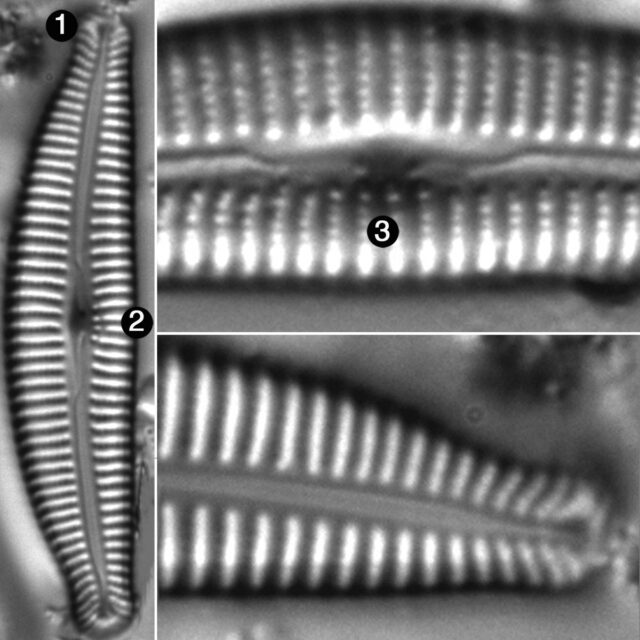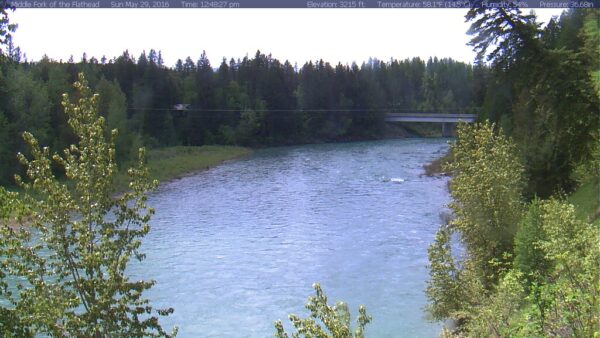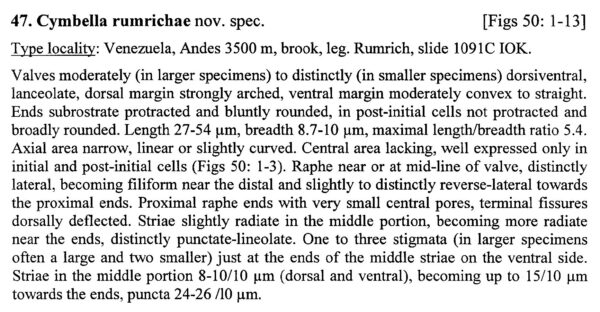Cymbella rumrichae
-
Category
-
Length Range22.1-56.6 µm
-
Width Range7.5-10.7 µm
-
Striae in 10 µm10-12 at the valve center, up to 15 near the apices
-
ContributorLoren Bahls - May 2016
-
ReviewerEvan Thomas - Jun 2016
Identification
Description
Valves are lanceolate to linear-lanceolate and dorsiventral with broadly rounded to rostrate apices. The dorsal margin is moderately arched; the ventral margin is weakly convex to nearly flat. The axial area is narrow. A central area is not evident on some specimens; on others it is small and rhombic. The raphe is lateral, becoming reverse-lateral near the proximal ends. Proximal raphe ends are deflected ventrally. Terminal raphe ends are deflected dorsally at 45 degrees. Striae are weakly radiate near the valve center, becoming strongly radiate near the apices. Areolae number 24-28 in 10 µm. One to five central stigmata may be present at the ends of the middle striae on the ventral side.
The specimens observed and presented here have a size range comparable to that of the type population from South America, as described by Krammer (2002). The larger specimens here, however, are not of the same shape as those in the original description. Further work is needed to clarify the relationship of the North American populations to the South American ones.
Autecology
Cymbella rumrichae has been collected from several mountain streams in the Waterton-Glacier International Peace Park in Alberta, Canada and Montana, USA. At the time of collection, one of these streams (Cameron Creek, Alberta) had a pH of 7.94 and a specific conductance of 171 µS/cm. This taxon was described from a brook at 3500 m elevation in the Andes Mountains of Venezuela (Krammer 2002).
-
Size Range, µm3
-
Motility
-
Attachment
-
Habitat
-
Colony
-
Waterbody
- Learn more about this
Citations & Links
Citations
Links
-
Index Nominum Algarum
Cite This Page
Bahls, L. (2016). Cymbella rumrichae. In Diatoms of North America. Retrieved October 30, 2024, from https://diatoms.org/species/cymbella_rumrichae
Responses
The 15 response plots show an environmental variable (x axis) against the relative abundance (y axis) of Cymbella rumrichae from all the stream reaches where it was present. Note that the relative abundance scale is the same on each plot. Explanation of each environmental variable and units are as follows:
ELEVATION = stream reach elevation (meters)
STRAHLER = distribution plot of the Strahler Stream Order
SLOPE = stream reach gradient (degrees)
W1_HALL = an index that is a measure of streamside (riparian) human activity that ranges from 0 - 10, with a value of 0 indicating of minimal disturbance to a value of 10 indicating severe disturbance.
PHSTVL = pH measured in a sealed syringe sample (pH units)
log_COND = log concentration of specific conductivity (µS/cm)
log_PTL = log concentration of total phosphorus (µg/L)
log_NO3 = log concentration of nitrate (µeq/L)
log_DOC = log concentration of dissolved organic carbon (mg/L)
log_SIO2 = log concentration of silicon (mg/L)
log_NA = log concentration of sodium (µeq/L)
log_HCO3 = log concentration of the bicarbonate ion (µeq/L)
EMBED = percent of the stream substrate that is embedded by sand and fine sediment
log_TURBIDITY = log of turbidity, a measure of cloudiness of water, in nephelometric turbidity units (NTU).
DISTOT = an index of total human disturbance in the watershed that ranges from 1 - 100, with a value of 0 indicating of minimal disturbance to a value of 100 indicating severe disturbance.

Cymbella rumrichae
- Apices broadly rounded to rostrate
- Valves 7.5-10.7 µm wide
- Stigmata 1-5
- Maximum length-to-width ratio 5.4
Valves are lanceolate to linear-lanceolate, 7.5-10.7 µm wide. Maximum length-to-width ratio is 5.4. Apices are broadly rounded to rostrate. Stigmata number 1-5.
 Diatoms of North America
Diatoms of North America








